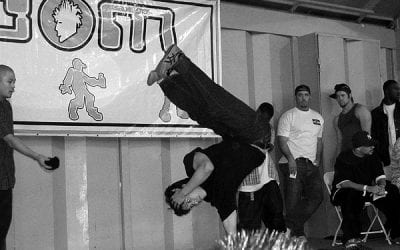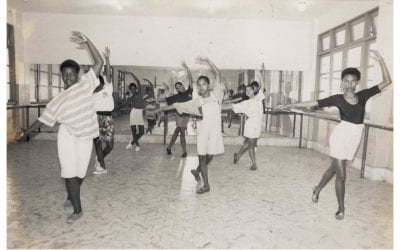Ballet Folklórico Mexicano

“Mexican Dance” by Dance Photographer – Brendan Lally is licensed under CC BY 2.0
Ballet folklórico—traditional Mexican folk dancing—has become a defining element of Mexican popular culture at the national and international levels, despite the prevalence of foreign influences in modern Mexican “pop” culture. Although its history is chaotic, ballet folklórico has successfully carved itself a niche in the Mexican psyche . Periodic waves of Mexican nationalism during the 19th and 20th centuries reinvigorated folk dance and kept it alive until the mid 20th century, when it was finally (and fully) adopted by popular culture. Ballet folklórico is not any one particular style of dance, but rather, an amalgamation reflecting the regional and ethnic diversity of Mexico. Indeed, the term encompasses all of the various traditional regional dances. Thus, the incorporation of ballet folklórico into popular culture cannot be traced to a specific event, but, rather, is the result of the converging forces of nationalism, mestizaje and indigenismo.
NATIONALISM—KEEPING FOLKLÓRICO ALIVE
Over the course of the past three centuries, ballet folklórico has served as a tool in the construction of a wholly “Mexican” national identity. Many regional dances currently performed existed as early as the 17th century, but were not firmly entrenched until after the 1810 War of Independence, when ballet folklórico received its first important surge of popularity. The jarabe dance (typical of Jalisco) became a political weapon, evoking feelings of patriotism and serving as a “symbol of liberty” (Maria Elena Sodi de Pallares, “La Sandunga” in México: Leyendas y Costumbres, Trajes y Danzas, Editorial Layac, 1945, p. 416). Indeed, the jarabe became so closely linked with the independence movement that it came to represent the nation as a whole and was renamed the Jarabe Mexicano. In turn, the Jarabe Mexicano spurred further interest in ballet folklórico by reviving many of the old sones describing Mexico’s “long and glorious history” (Sodi de Pallares 416). Ultimately, the War converted folkloric dance into an expression of “national soul” and encouraged a greater “interest and fondness” for “Mexican antiquities” (Marta Herieda Casanova, El Jarabe: Baile Nacional de México, Secretaría de Cultura, Gobierno de Jalisco, 1999, p. 20).
After the 1910 Revolution, ballet folklórico blossomed as a result of the dramatic changes that occurred in Mexican society. First, the Revolution inspired folkloric songs and dances like Adelita, La Valentina, and La Cucaracha, which remain popular today. Second, Mexican consciousness expanded, making the average citizen aware of native indigenous populations and inspiring a cultural movement to “retake themes and re-elaborate forms of pre-Hispanic culture, and give form to a nationalism which mixed indigenous, creole, and mestizo elements” (Esperanza Jiménez de Pomar, “La Danza en México,” in La Danza en México, El Colegio de Sinaloa, 1999, p. 85; Ruth D. Lechuga, El Traje de los Indígenas de México, Panorama Editorial, S.A., 1991, p. 120). Fourth, the nationalist movement—particularly during the 1920s—used art as an instrument to forge the Mexican nation and to reject foreign aesthetic influences (Alan Knight, “The Rise and Fall of Cardenismo, c. 1930-1946,” in Mexico since Independence, Cambridge University Press, 1991, p. 266).
The 1910 Revolution was ultimately the most important impetus behind the evolution of ballet folklórico, as the resulting nationalist movements embraced indigenous art forms and re-identified ballet folklórico as a national expression.
During the 1930s, under the administration of Mexico’s great populist president Lázaro Cárdenas (1934-1940), the great popularity of early performances prompted greater interest in aesthetic education and thereby expose a greater number of people to ballet folklórico. Educational centers throughout Mexico gave dance classes and the Departamento de las Bellas Artes created a Dance School in the Federal District in 1932 (Jiménez de Pomar 87).
Despite an overall decline in popularity in the 1950s and 1960s, the Mexican government again made a concerted effort to promote folkloric dance and preserve it for its aesthetic and social value. The government subsidized ballet folklórico companies. In 1952, Amalia Hernandez founded the Ballet Folklórico de México (arguably the most famous company in Mexico), and by 1959, had a contract with the Instituto Nacional de Bellas Artes (INBA) to perform at the national theater, the Palacio Bellas Artes once a week. The Ballet Folklórico Nacional de México was founded in 1960, and by 1970, had been named the “official folkloric dance company of Mexico” (Jiménez de Pomar 91). Additionally, to encourage the teaching of folk dances in urban and rural public schools, the government made ballet folklórico classes a requirement, and offered summer sessions at the University of Mexico (UNAM) (Gertrude X. Mooney, Mexican Folk Dances for American Schools, University of Miami Press, 1957, p. 5).
MESTIZAJE AND INDIGENISMO: BRINGING CULTURES TOGETHER/ REMEMBERING THE PAST
While the continued presence of ballet folklórico is due in large part to the resurging nationalist movement, the evolution of its form is the result of mestizaje (the combination of European, indigenous, and African cultures) and indigenismo (a movement to preserve indigenous culture). Reflecting these dual forces, some folkloric dances incorporated Spanish and other European styles while others adapted or preserved their traditional indigenous roots.
Although widely recognized as the primary impetus driving cultural change in Mexico, mestizaje often resulted from forced cultural mixing which caused indigenous traditions to “suffer a transformation” (Leopoldo Sánchez, “El Folclore y la Danza Regional en Mexico,” in La Danza en México, El Colegio de Sinaloa, 1999, p. 17). Where mestizaje did not eliminate or forcibly change native culture, it affected traditional dances in one of two ways. In some cases, mestizaje resulted in the direct importation of European dances. These dances include Los Moros y Christianos—a mock battle between Moors and Christians which was introduced in the central states—as well as Los Arcos, Las Escadas, Los Machetes, El Paloteo, Las Cintas, and Los Doce Pares (Sánchez 18). The Spaniards also brought dances like La Zambra, La Zarabanda, La Contradanza, seguidillas, fandangos, huapangos, jotas, boleros, zambras, and zapateados. Other European countries contributed court dances such as La Polea, La Redova, La Galopa, La Mazurca, and La Varsovianna. (Jiménez de Pomar 75; Mooney 2). In other cases, mestizaje resulted in either Mexican interpretations of European dances or entirely new choreography.
This synthesis is evident throughout the ballet folklórico repertoire. The baile and the son, for instance, were products of indigenous and European influences. Folkloric dances incorporated characteristics of European dances such as steps, themes, patterns, finger snappings, masquerade costumes, wood sticks or clubs and flower-entwined arcs. Mestizaje also introduced Afro and Caribbean traditions to Mexico, producing specific dances such as Los Negritos, and types of dance such as the huapango and the son. Moreover, Afro—and in particular, Cuban—rhythms have shaped music and dance in the eastern states of Mexico, including Veracruz, Puebla, and Michoacán (Mooney 2-4).
The other critical force behind the evolution of ballet folklórico has been indigenismo—the fierce desire of indigenous groups to preserve their traditions even in the face of mestizaje. Indigenismo historically involved continuous resistance by native communities against European contact and influence. Their struggle is all the more noteworthy given the Mexican government’s periodic attempts to create a cohesive homogenous national identity (Agustín Jacinto Zavala, “Algunos Problemas en el Estudio de la Identidad Étnica,” in Tradición e Identidad en la Cultural Mexicana, El Colegio de Michoacán, 1992, p. 59). Over the past 20 years, indigenismo has become far more overt and political.. Indeed, as a result of the political mobilization of indigenous peoples in Mexico, there is now a greater interest in the preservation of pre-Hispanic cultural forms.
Ballet folklórico incorporates many of native dances, such as Los Voladores, Los Quetzales, Los Vieijitos, and El Venado, recognizing them as illustrations of the multi-faceted Mexican soul. The actual “purity” of these indigenous dances is under debate, as many were originally religious or ceremonial in nature (Guillermo Jiménez, Danzas de Mexico, Ediciones de Arte, S.A., 1948, p. 2). Because conversion of indigenous peoples was a primary goal during colonization, religious dances were largely eradicated or disassociated from their “pagan” religious elements by missionaries who adapted them to Christian themes. Nevertheless, some dances have survived largely untouched by European influences because indigenous groups in remote regions inaccessible to colonizers continue to practice their traditions (Mooney 3).
BRIDGING THE GAP
Creating a detailed history of ballet folklórico may never be possible. The flow of time separates traditions from their modern practice. The Mexican government’s emphasis on political and economic stability—to the exclusion of cultural preservation—does not help either. Nonetheless, Mexico’s periodic nationalist movements clearly spurred the preservation of certain dances and traditions because they were deemed “Mexican” and were absorbed into the popular culture. Furthermore, ballet folklórico has not only benefited from the strong influence of mestizaje, but is also one of the few areas in Mexican society in which indigenous practices have been conserved and cultivated (rather than suffering outright elimination). Thus, ballet folklórico permits Mexican popular culture to bridge the gap between past and present, serving as a tangible link between the pre-Hispanic cultures and the mestizo culture of modern Mexico.
Related Articles
Editor’s Letter: Dance!
We were little black cats with white whiskers and long tails. One musical number from my one and only dance performance—in the fifth grade—has always stuck in my head. It was called “Hernando’s Hideaway,” a rhythm I was told was a tango from a faraway place called Argentina.
Brazilian Breakdancing
When you think about breakdancing, images of kids popping, locking, and wind-milling, hand- standing, shoulder-rolling, and hand-jumping, might come to mind. And those kids might be city kids dancing in vacant lots and playgrounds. Now, New England kids of all classes and cultures are getting a chance to practice break-dancing in their school gyms and then go learn about it in a teaching unit designed by Veronica …
Dance Revolution: Creating Global Citizens in the Favelas of Rio
Yolanda Demétrio stares out the window of our public bus in Rio de Janeiro, on our way to visit her dance colleagues at Rio’s avant-garde cultural center, Fundição Progresso. Yolanda is a 37-year-old dance teacher, homeowner, social entrepreneur and former favela (Brazilian urban shantytown) resident. She is the founder and director of Espaço Aberto (Open Space), an organization through which Yolanda has nearly …




